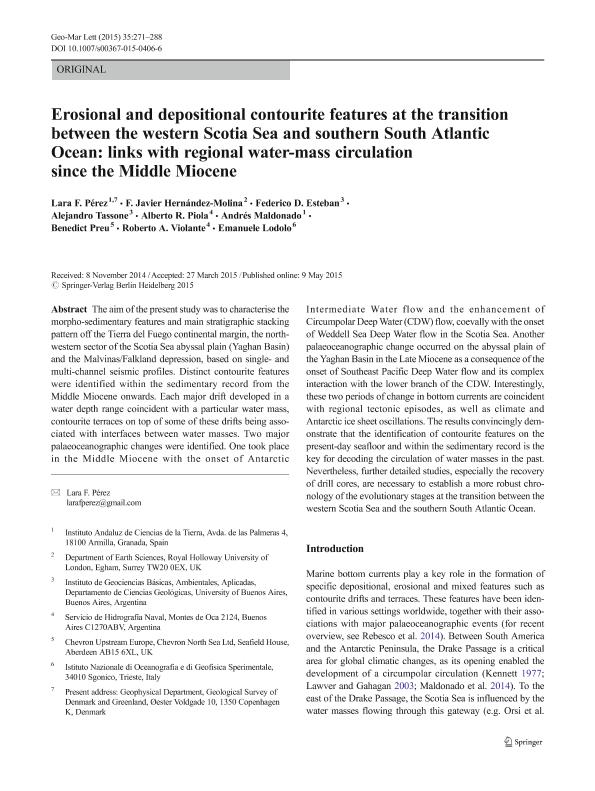Mostrar el registro sencillo del ítem
dc.contributor.author
Pérez, Lara F.
dc.contributor.author
Hernández Molina, F. Javier
dc.contributor.author
Esteban, Federico Damián

dc.contributor.author
Tassone, Alejandro Alberto

dc.contributor.author
Piola, Alberto Ricardo

dc.contributor.author
Maldonado, Andrés
dc.contributor.author
Preu, Benedict
dc.contributor.author
Violante, Roberto Antonio

dc.contributor.author
Lodolo, Emanuele

dc.date.available
2018-04-11T20:07:36Z
dc.date.issued
2015-08
dc.identifier.citation
Pérez, Lara F.; Hernández Molina, F. Javier; Esteban, Federico Damián; Tassone, Alejandro Alberto; Piola, Alberto Ricardo; et al.; Erosional and depositional contourite features at the transition between the western Scotia Sea and southern South Atlantic Ocean: links with regional water-mass circulation since the Middle Miocene; Springer; Geo-marine Letters; 35; 4; 8-2015; 271-288
dc.identifier.issn
0276-0460
dc.identifier.uri
http://hdl.handle.net/11336/41782
dc.description.abstract
The aim of the present study was to characterise the morpho-sedimentary features and main stratigraphic stacking pattern off the Tierra del Fuego continental margin, the north-western sector of the Scotia Sea abyssal plain (Yaghan Basin) and the Malvinas/Falkland depression, based on single- and multi-channel seismic profiles. Distinct contourite features were identified within the sedimentary record from the Middle Miocene onwards. Each major drift developed in a water depth range coincident with a particular water mass, contourite terraces on top of some of these drifts being associated with interfaces between water masses. Two major palaeoceanographic changes were identified. One took place in the Middle Miocene with the onset of Antarctic Intermediate Water flow and the enhancement of Circumpolar Deep Water (CDW) flow, coevally with the onset of Weddell Sea Deep Water flow in the Scotia Sea. Another palaeoceanographic change occurred on the abyssal plain of the Yaghan Basin in the Late Miocene as a consequence of the onset of Southeast Pacific Deep Water flow and its complex interaction with the lower branch of the CDW. Interestingly, these two periods of change in bottom currents are coincident with regional tectonic episodes, as well as climate and Antarctic ice sheet oscillations. The results convincingly demonstrate that the identification of contourite features on the present-day seafloor and within the sedimentary record is the key for decoding the circulation of water masses in the past. Nevertheless, further detailed studies, especially the recovery of drill cores, are necessary to establish a more robust chronology of the evolutionary stages at the transition between the western Scotia Sea and the southern South Atlantic Ocean.
dc.format
application/pdf
dc.language.iso
eng
dc.publisher
Springer

dc.rights
info:eu-repo/semantics/openAccess
dc.rights.uri
https://creativecommons.org/licenses/by-nc-sa/2.5/ar/
dc.subject
Contourite
dc.subject
Water-Mass Circulation
dc.subject
Western Scotia Sea
dc.subject
Southern South Atlantic Ocean
dc.subject.classification
Meteorología y Ciencias Atmosféricas

dc.subject.classification
Ciencias de la Tierra y relacionadas con el Medio Ambiente

dc.subject.classification
CIENCIAS NATURALES Y EXACTAS

dc.title
Erosional and depositional contourite features at the transition between the western Scotia Sea and southern South Atlantic Ocean: links with regional water-mass circulation since the Middle Miocene
dc.type
info:eu-repo/semantics/article
dc.type
info:ar-repo/semantics/artículo
dc.type
info:eu-repo/semantics/publishedVersion
dc.date.updated
2018-04-11T15:15:42Z
dc.identifier.eissn
1432-1157
dc.journal.volume
35
dc.journal.number
4
dc.journal.pagination
271-288
dc.journal.pais
Alemania

dc.journal.ciudad
Berlín
dc.description.fil
Fil: Pérez, Lara F.. Instituto Andaluz de Ciencias de la Tierra; España. Geological Survey of Denmark and Greenland; Dinamarca
dc.description.fil
Fil: Hernández Molina, F. Javier. Royal Holloway University of London; Reino Unido
dc.description.fil
Fil: Esteban, Federico Damián. Consejo Nacional de Investigaciones Científicas y Técnicas. Oficina de Coordinación Administrativa Ciudad Universitaria. Instituto de Geociencias Básicas, Aplicadas y Ambientales de Buenos Aires. Universidad de Buenos Aires. Facultad de Ciencias Exactas y Naturales. Instituto de Geociencias Básicas, Aplicadas y Ambientales de Buenos Aires; Argentina
dc.description.fil
Fil: Tassone, Alejandro Alberto. Consejo Nacional de Investigaciones Científicas y Técnicas. Oficina de Coordinación Administrativa Ciudad Universitaria. Instituto de Geociencias Básicas, Aplicadas y Ambientales de Buenos Aires. Universidad de Buenos Aires. Facultad de Ciencias Exactas y Naturales. Instituto de Geociencias Básicas, Aplicadas y Ambientales de Buenos Aires; Argentina
dc.description.fil
Fil: Piola, Alberto Ricardo. Ministerio de Defensa. Armada Argentina. Servicio de Hidrografía Naval; Argentina. Consejo Nacional de Investigaciones Científicas y Técnicas; Argentina
dc.description.fil
Fil: Maldonado, Andrés. Instituto Andaluz de Ciencias de la Tierra; España
dc.description.fil
Fil: Preu, Benedict. Chevron North Sea; Reino Unido
dc.description.fil
Fil: Violante, Roberto Antonio. Ministerio de Defensa. Armada Argentina. Servicio de Hidrografía Naval; Argentina
dc.description.fil
Fil: Lodolo, Emanuele. Istituto Nazionale di Oceanografia e di Geofisica Sperimentale; Italia
dc.journal.title
Geo-marine Letters

dc.relation.alternativeid
info:eu-repo/semantics/altIdentifier/url/http://link.springer.com/article/10.1007%2Fs00367-015-0406-6
dc.relation.alternativeid
info:eu-repo/semantics/altIdentifier/doi/http://dx.doi.org/10.1007/s00367-015-0406-6
Archivos asociados
